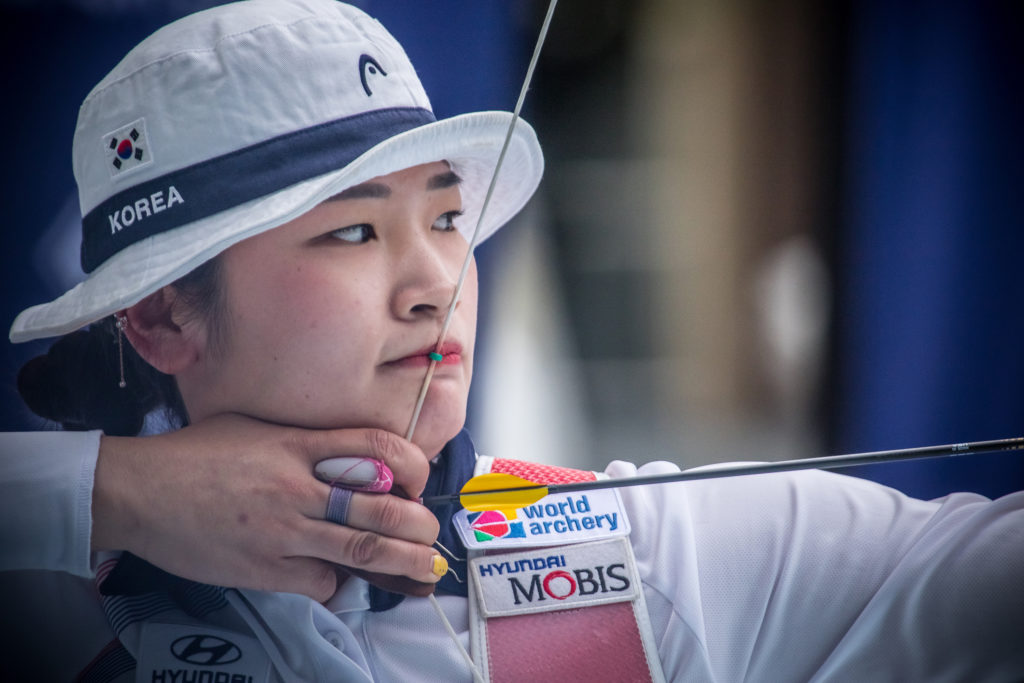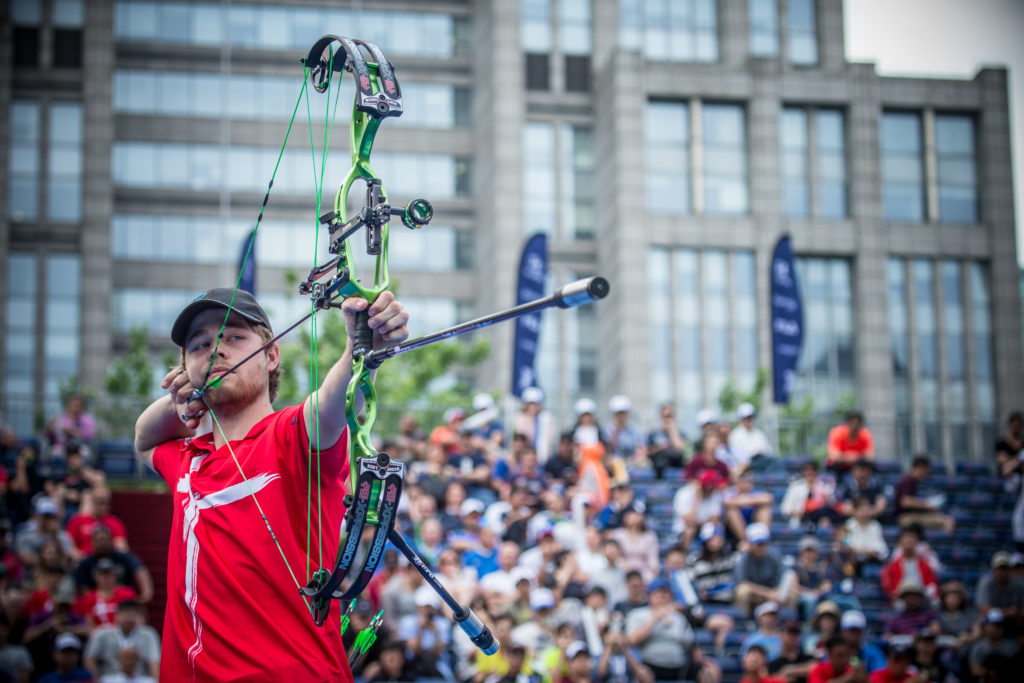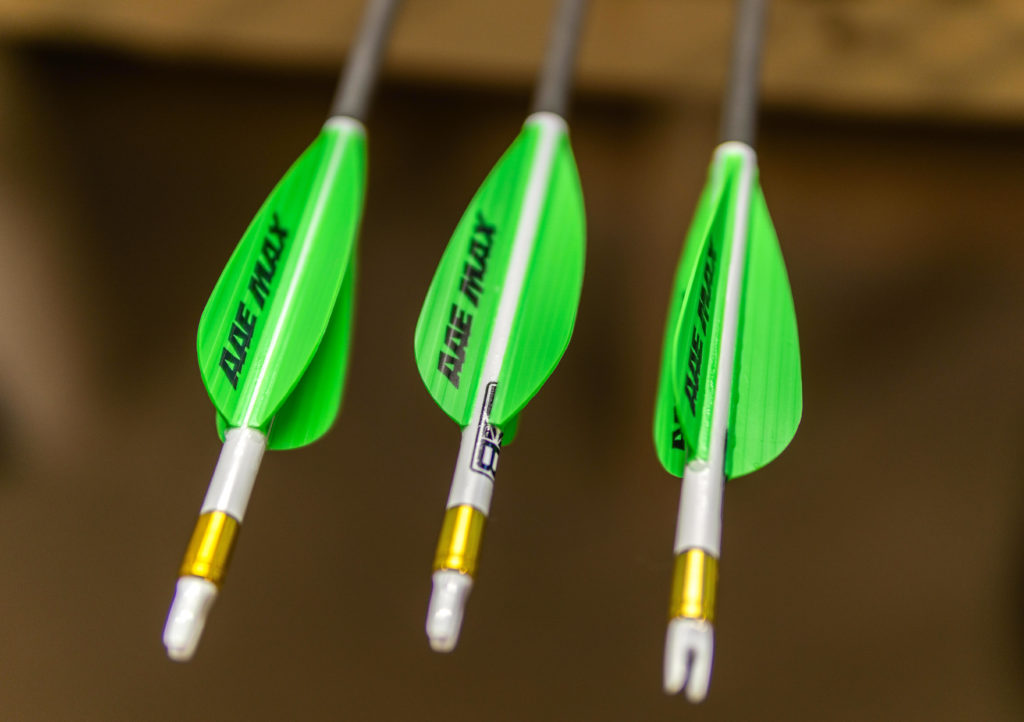We’re offering the latest archery advice from our experts here at Bow International
Q: I’m thinking about trying a kisser button. They seem to go in and out of fashion?

A: The kisser button is a simple device attached to your recurve bow string to help with shot consistency. The logic behind it is that it is one more reference point on the face to ensure that the string and drawing hand are set in the same position shot after shot.
Attaching the kisser button accurately to the string is essential, and it is important that it references a place on the face that cannot or does not move during the normal shot cycle. Most set it up so that it touches a certain part of the top lip: hence the term kisser button.
Unlike stabilisers and clickers, a kisser button is not universally used by the very best archers; it is more of a personal choice by the archer and/or their coach.
However, there are some very high-profile archers that do use them, such as current world number one Kang Chae Young. So it is a case of trying it to see if it helps to improve your scores, although a warning: you need to try one for some time.
My advice is that you cannot fit one during an evening session and make an instant decision. Like all changes to your equipment and shooting form, your subconscious brain needs time to get used to it.
Manufacturers make kisser buttons in all shapes and sizes, although some archers use a simple brass nocking point crimped on to the string. Apart from the necessity to fit it in the correct place, once fitted it is important to check your bow tune and arrow selection.
Although kisser buttons tend to be light, they are fitted close to the middle of the string, where its weight has the greatest effect on the string travel. A kisser button will slow down the speed of the string, resulting in less energy being transferred to the arrow; it will also affect the side to side movement of the string and therefore the bend of the arrow shaft.
Slowing down the string slows down the speed of the arrow; if you have correctly selected arrow shafts then this will only require a minor adjustment to spring tension, centre shot and/or bracing height.
Without adjusting your bow tune, your arrows will most probably not bend enough around your riser and there may be some contact with the riser resulting in a metallic sound and a less quiet bow.
It would seem that adding a kisser has more pitfalls than benefits. However, target archery is all about consistency, we want to put all our arrows in a group in the highest scoring zone. The kisser button can help the archer to achieve this by adding one more positive reference point to the shot cycle.
Andrew Smith
Q: What is the thinking behind the side rod placement positions that the elite compounders use?

Recurve stabilisation has assumed a remarkably consistent set-up, with a long front rod, and the V bar twin short rod positioned behind. Virtually every top level recurver, for decades now, has adopted this formation.
Compounders however, have resorted to varying positions, lengths, weight distributions, until today’s elite now seem generally, to have settled upon the long front rod, and a single side rod, positioned either at grip height, or lower down on the bottom of the riser handle.
A few top compounders (such as Sarah Prieels, winner of a $10,000 shoot-off in Vegas in 2020) do use twin rods, but the general preference overall is for a single short side rod, length around 15 inches, angled back quite sharply, positioned low down, and with considerably more ounces attached than on the long front stabiliser.
Some still prefer the higher, less sharply angled short rod – greats such as Reo Wilde, Dave Cousins and Mike Schloesser among them.
Compounders work on basically two stabilisation principles, and these of course are governed by the comfort and feel the particular archer prefers. One option is a balance focus, while the other is driven by a resistance set up, which works in harmony with the shot execution.
The former works on the adage that the bow is set up so no dominance is in play on any particular axis. In other words, the bow sits steady with a non-aggressive shot execution.
This can work really well. The resistance option works more dynamically with a particular axis working with shot execution to keep a steady sight picture, a sort of unison effort between the bow and the archer. Compounders who have an aggressive execution favour this option.
So it gets down as always, to a comfort and feel factor. A ‘balance type’ set-up usually means a certain weight out front and considerably more ounces out back. The actual amounts correspond to as much mass weight as the particular archer can comfortably handle.
A resistance set up is more likely to have much less back weight relative to the front, perhaps only up to 10 ounces difference and is often set up off the front rod bushing, and at a wider angle than those who utilise the low bushing. So it’s really a matter of determining which geometry fits your feel and comfort best.
Roy Rose
Q: Is it worth trying a four-fletched arrow? There’s a lot of furious debate about it online.

Pic: standsureoutdoors.com
Whether or not four fletches are better than three is a hotly debated topic in archery forums with both sides fighting their corner fiercely. It’s also a very difficult subject to write about as it’s not standard practice here in the UK, nor does it seem to have any application for recurve shooting or target archery.
Most of the advocates for four fletch that I have seen posting are from the bow hunting community; this is especially true on arrows that are fitted with heavy broadheads.
These element makes this subject a bit vague and difficult to implement metrics to judge this issue. Therefore, my answer will be based upon personal opinion, which will be grounded by physics.
Having an extra vane should in theory provide a higher degree of steering and stabilisation due to adding another flight control surface. The extra fletch will impart more drag and lead to a small loss in down range arrow speed.
The extra weight at the rear will also have to be taken into account when considering the entire arrow as one system especially when it comes to determining a specific F.O.C percentage figure. Obviously adding extra bits to an arrow has a financial implication, too.
The cost of building a dozen arrows could increase by around £5.00 if you are using plastic vanes, or a lot more if using feathers. If you are building your own arrows you will also have to ensure that your tooling is capable of configuring a four-fletched format.
It is possible that a user of a four-fletched arrow could encounter bow clearance issues. This will be determined by the arrows diameter, vane length and profile and the type of rest/launcher used.
Interestingly, both sides for and against four fletch claim that their option is the more crosswind efficient. My thinking is that the something with more surface area is less wind efficient.
Vanes and feathers come in all different length, shapes and sizes. Therefore it’s possible to get the same amount of performance from a standard configuration if the size and profile are more efficient than those of a four-fletched format. Stabilisation and rotation can always be increased with an offset or helical fletch.
Arrow speed is a massive contributing factor when attempting to assess stability. The faster an arrow travels the less stabilisation it requires. As compound bows are shooting very fast I doubt there will be much accuracy difference between three or four fletches.
A good indicator as to what really works is to look at what formats all the professionals are using. The elite archers and their coaches are very adept at crunching figures and data to see if something really works or not. I see all the top shooters using a standard three-fletched format.
In all the years that I have been making arrows I have never been asked to deviate from the standard format. These factors combined tells me that four fletched arrows aren’t warranted for target archery and may possibly cause more problems than advantage gained.
I believe that if you have a well tuned bow shooting a well-made matched arrow there really shouldn’t be any need for four fletches. Don’t try to fix what isn’t broken. There are more points to be had via keeping still and perfectly repeating a shot than anything else.
Andrew Tippins
Thanks to Rob Monaghan for the question. Thanks to standsureoutdoors.com for the arrows pic.

